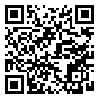BibTeX | RIS | EndNote | Medlars | ProCite | Reference Manager | RefWorks
Send citation to:
URL: http://jdisabilstud.org/article-1-1400-en.html
2- Faculty of Psychology and Education, University of Tehran
3- Pediatric Neurorehabilitation Research Center, University of Social Welfare & Rehabilitation Sciences (USWR)
Background & Objectives: Hearing loss is one of the most common childhood disorders, which greatly impacts communication and the development of speech and language skills. In recent years, researchers have emphasized the importance of timely intervention in the treatment and rehabilitation of hearing loss from the beginning of infancy. Cochlear implantation is one of the promising therapies recently developed for deaf children. The age of diagnosis and intervention has also received much attention recently, and the reduction in the age of diagnosis to the first week after birth, as well as the decrease in cochlear implantation age to ten months, is a testament to this development. The effect of music therapy in the field of complementary therapies has also been expanded. Therefore, the present study aims to develop an educational program based on music therapy and the content of lullabies and motion and rhythmic songs. Then, we examine the effectiveness of this program on communication skills and parent–child interaction for deaf cochlear implantation children under the age of three years.
Methods: This research method was quasi–experimental with a pretest–posttest design with a control group. The present study population comprised all pairs of Iranian hearing mothers and their deaf children with cochlear implants (less than three years old, prelingual stage). A total of 22 couples were selected by a purposive convenience sampling method from those referring to Rasul–e Akram Implantation Center (ten couples in the experimental group and twelve couples in the control group). The study data in the pretest and posttest were gathered via Category of Auditory Performance (CAP–II) (Archbold et al., 1995), Speech Intelligibility Rating (SIR) Scale (Allen et al., 1998), and Parent–Child Interaction Scale (Pianta, 1994). The experimental group participated in sessions performed with lullaby content and rhythmic and movement songs in the sensory integration room of the Cochlear Implant Center of Rasoul–e–Akram Hospital. The control group only received the usual rehabilitation program in the center and the cities where they lived. To analyze the obtained data, descriptive statistics (mean and standard deviation) and inferential statistics (univariate covariance analysis) were used to investigate the difference between pretest and posttest scores and the difference between groups. Data analysis was done in SPSS software version 23 at a significance level of 0.05.
Results: By removing the effect of the pretest, the communication skills of the experimental group compared with the control group showed a significant difference in the variables of listening comprehension (p<0.001) and speech intelligibility (p<0.001). Parent–child interaction was not significant in the subscales of closeness, dependence, and conflict reduction. Only in the proximity subscale the effect size was between low and medium with a value of 0.11, and it was also improved in the qualitative assessment of parents.
Conclusion: The research findings showed the effectiveness of the educational program of lullabies and movement and rhythmic songs in increasing listening comprehension and speech intelligibility and at least on one of the components of the parent–child interaction scale, i.e., closeness. Therefore, it can be a valuable educational program to increase the learning of other exceptional group disorders.
| Rights and permissions | |
 |
This work is licensed under a Creative Commons Attribution-NonCommercial 4.0 International License. |





